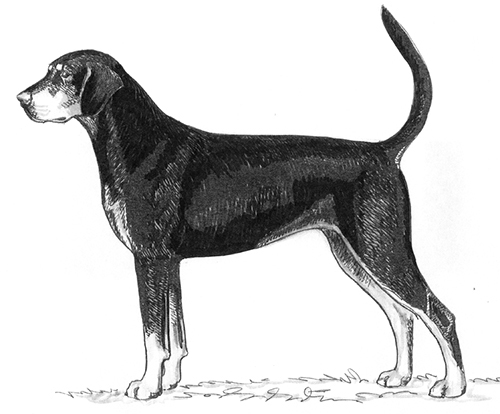Transylvanian Hound
Scenthound Group
The goals and purposes of this breed standard include: to furnish guidelines for breeders who wish to maintain the quality of their breed and to improve it; to advance this breed to a state of similarity throughout the world; and to act as a guide for judges.
Breeders and judges have the responsibility to avoid any conditions or exaggerations that are detrimental to the health, welfare, essence and soundness of this breed, and must take the responsibility to see that these are not perpetuated.
Any departure from the following should be considered a fault, and the seriousness with which the fault should be regarded should be in exact proportion to its degree and its effect upon the health and welfare of the dog and on the dog’s ability to perform its traditional work.
History
The Transylvanian Hound is an ancient Hungarian breed. It was the favorite hunting dog of the aristocracy during the Middle Ages. As a result of the varying terrains, two varieties of the breed eventually developed, one with long legs and one with shorter legs. At the beginning of the 20th Century, the breed was nearly extinct. The breed was revived beginning in 1968. The short legged variety of the breed disappeared, but there are a significant number of the long legged dogs now in Hungary and Romania.
The Transylvanian Hound was recognized by the United Kennel Club in 2006.
General Appearance
Medium sized, athletically built, neither coarse nor fine.
Characteristics
Good natured and courageous, with a quiet but determined character.
Head
The head is long, but not pointed. The skin on the head is close fitting and free of wrinkles.
SKULL
The skull is slightly domed. The occiput is not pronounced. The stop is slight.
MUZZLE
The muzzle is the same length as the skull. It has a straight nasal bridge, and dry, tight fitting, black lips.
TEETH
The Transylvanian Hound has a complete set of evenly spaced, white teeth meeting in a scissors bite.
Disqualifications: Any deviation from a scissors bite.
NOSE
The nose is wide and black.
EYES
The medium sized, almond shaped eyes are set slightly obliquely. They are dark brown in color, and have close fitting lids.
EARS
The ears are set medium high and hang close to the cheeks without being folded. They widen from the base and then taper to rounded tips. When pulled forward they should just cover the eye.
Disqualifications: Prick, semi-prick, or rose ears.
Neck
Medium length and very muscular. There are slight folds of skin under the throat. A small dewlap is acceptable.
Forequarters
The shoulder blades are long, and moderately sloping.
FORELEGS
The legs are straight and parallel, and set fairly well apart. The elbows are close to the chest.
Body
The body is slightly longer than tall in proportion. The chest is broad, long and not too deep. The point of the sternum does not protrude. The withers are pronounced and the topline is straight. The croup is slightly sloping and there is slight tuck-up.
Hindquarters
HIND LEGS
The legs are long and well muscled. The hocks are low set.
Feet
Large and well knit, with cushioned pads.
Tail
The tail is set on at medium height, and reaches slightly beyond the hocks. It is carried curved, but not curled over the back.
Coat
The coat is short, straight, dense and flat. It is coarse to the touch and shiny and may have ridges or cowlicks. There is an undercoat.
Serious Faults: Wiry, soft, wavy or sparse coat.
Color
Tri-color, with a black base color, tan on the muzzle, legs and eyebrows, and white markings on the head, neck, chest, lower legs and tip of tail. Excessive white is undesirable.
Disqualifications: Brown or blue base color.
Height and Weight
Height at the withers is 21.5 to 25.5 inches. Minimum weight is 55 pounds.
Gait
Long and ground covering, never mincing.
Disqualifications
(A dog with a Disqualification must not be considered for placement in a conformation event, and must be reported to UKC.)
Unilateral or bilateral cryptorchid.
Viciousness or extreme shyness.
Albinism.
Any deviation from a scissors bite.
Prick, semi-prick, or rose ears.
Brown or blue base color.

Looking for a Dog?
Find a dog that will fit your family.
Note: The breeders on this list are not endorsed by UKC.
©Copyright 2006, United Kennel Club
